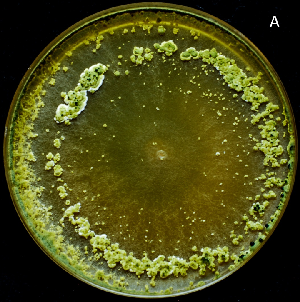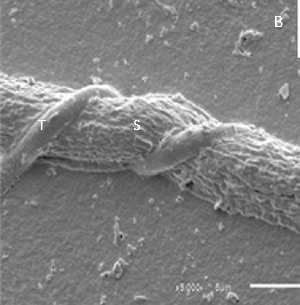

The asexual (or anamorphic) T. harzianum is the most
common Trichoderma species as it is the most frequent
Trichoderma spp. in the majority of samples
worldwide. It has often even been synonymized with
Trichoderma biocontrol agents in general, as it is the
principal component in several commercial bio-fungicide
formulations. This biocontrol ability is commonly associated with
other Trichoderma activities, for example, the ability to
produce a great variety of antifungal metabolites like secondary
metabolites and hydrolytic enzymes.
In addition to their mycoparasitic activity, Trichoderma
species are rhizosphere-competent, being able to colonize and grow
in association with plant shoots and roots as previously described
for cucumber, cotton, maize, tomato, pepper, lettuce, bean, and
other plants. This association changes the plant development
(growth and metabolism) and also induces defense responses and
resistance to subsequent fungal attack. This Trichoderma
strain was isolated from Brazilian Cerrado soil and exhibited
efficient biological control against the fungi Rhizoctonia
solani, Fusarium solani, Sclerotinia
sclerotiorum, and other pathogens that impact dry bean crop
production in Brazil. This genome will provide a suitable platform
for biotechnological applications.
Genome Reference(s)
Kubicek CP, Steindorff AS, Chenthamara K, Manganiello G, Henrissat B, Zhang J, Cai F, Kopchinskiy AG, Kubicek EM, Kuo A, Baroncelli R, Sarrocco S, Noronha EF, Vannacci G, Shen Q, Grigoriev IV, Druzhinina IS
Evolution and comparative genomics of the most common Trichoderma species.
BMC Genomics. 2019 Jun 12;20(1):485. doi: 10.1186/s12864-019-5680-7
Steindorff AS, Ramada MH, Coelho AS, Miller RN, Pappas GJ Jr, Ulhoa CJ, Noronha EF
Identification of mycoparasitism-related genes against the phytopathogen Sclerotinia sclerotiorum through transcriptome and expression profile analysis in Trichoderma harzianum.
BMC Genomics. 2014 Mar 18;15():204. doi: 10.1186/1471-2164-15-204
